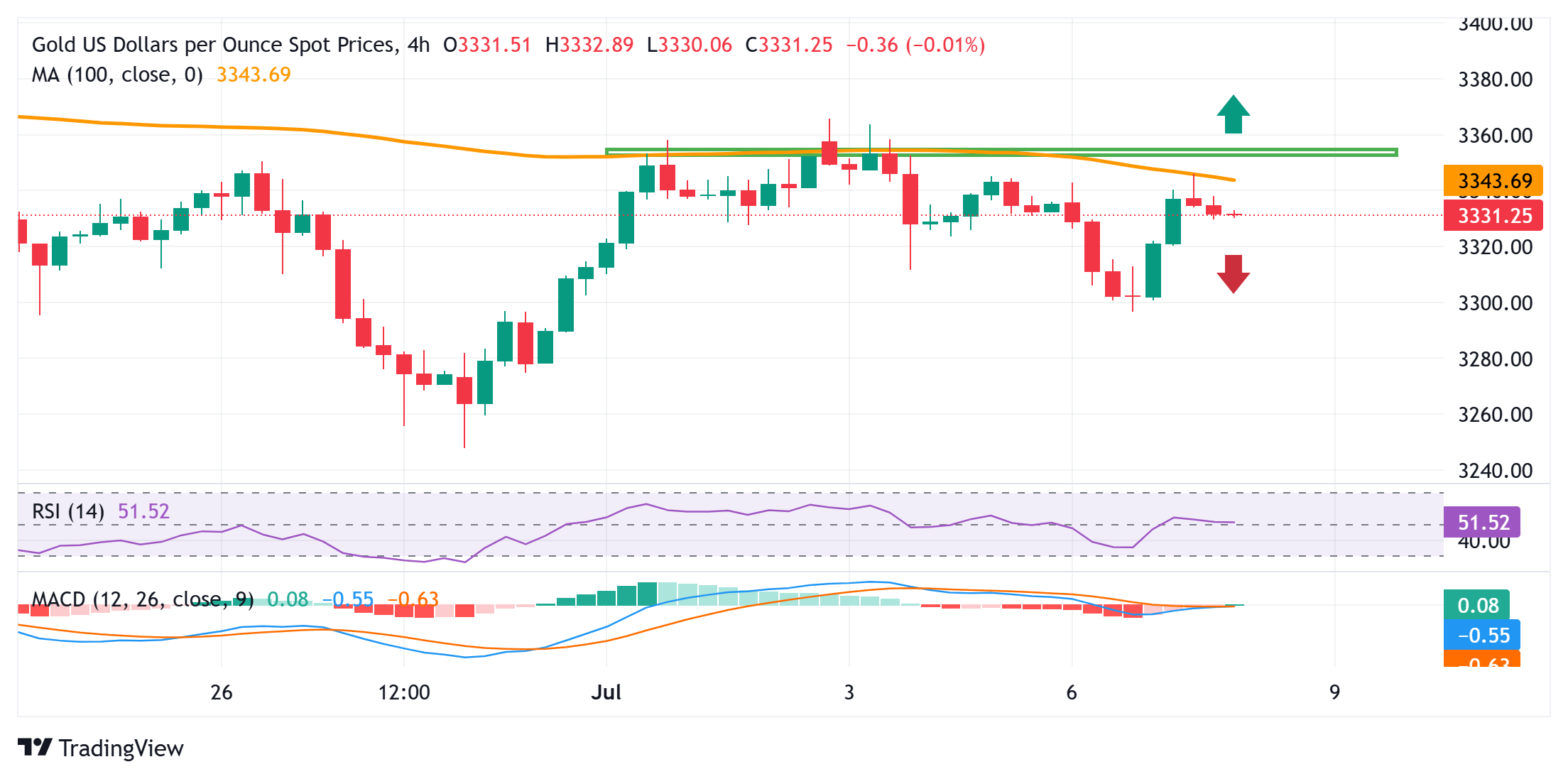Created
: 2025.07.08














![]() 2025.07.08 13:44
2025.07.08 13:44
Gold price (XAU/USD) struggles to capitalize on the previous day's goodish rebound from a one-week low - levels just below the $3,300 mark - and trades with a mild negative bias during the Asian session on Tuesday. Expectations that US President Donald Trump's tariffs would underpin US inflation in the coming months and force the Federal Reserve (Fed) to keep interest rates steady act as a headwind for the non-yielding yellow metal. However, a combination of factors might hold back traders from placing aggressive bearish bets and help limit the downside for the commodity.
Investors remain on edge amid worries about the potential economic fallout from Trump's so-called reciprocal tariffs. This, along with persistent geopolitical risks, takes its toll on the global risk sentiment and should benefit the safe-haven Gold price. Apart from this, the emergence of some US Dollar (USD) selling could offer some support to the precious metal. Traders might also opt to wait for more cues about the Fed's rate-cut path before positioning for the next leg of a directional move. Hence, the market focus will remain glued to the release of the FOMC meeting minutes on Wednesday.

The overnight goodish rebound faced rejection near the 100-period Simple Moving Average (SMA) on the 4-hour chart. The said barrier is currently pegged near the $3,347-3,348 region and is followed by $3,358-3,360 supply zone. A sustained strength beyond the latter could trigger a short-covering move and allow the Gold price to reclaim the $3,400 round figure.
On the flip side, the $3,300-3,295 area might continue to protect the immediate downside, below which the XAU/USD pair could accelerate the fall towards the next relevant support near the $3,270 horizontal zone. The downward trajectory could get extended and eventually drag the Gold price to the $3,248-3,247 region, or the June monthly swing low.
Monetary policy in the US is shaped by the Federal Reserve (Fed). The Fed has two mandates: to achieve price stability and foster full employment. Its primary tool to achieve these goals is by adjusting interest rates. When prices are rising too quickly and inflation is above the Fed's 2% target, it raises interest rates, increasing borrowing costs throughout the economy. This results in a stronger US Dollar (USD) as it makes the US a more attractive place for international investors to park their money. When inflation falls below 2% or the Unemployment Rate is too high, the Fed may lower interest rates to encourage borrowing, which weighs on the Greenback.
The Federal Reserve (Fed) holds eight policy meetings a year, where the Federal Open Market Committee (FOMC) assesses economic conditions and makes monetary policy decisions. The FOMC is attended by twelve Fed officials - the seven members of the Board of Governors, the president of the Federal Reserve Bank of New York, and four of the remaining eleven regional Reserve Bank presidents, who serve one-year terms on a rotating basis.
In extreme situations, the Federal Reserve may resort to a policy named Quantitative Easing (QE). QE is the process by which the Fed substantially increases the flow of credit in a stuck financial system. It is a non-standard policy measure used during crises or when inflation is extremely low. It was the Fed's weapon of choice during the Great Financial Crisis in 2008. It involves the Fed printing more Dollars and using them to buy high grade bonds from financial institutions. QE usually weakens the US Dollar.
Quantitative tightening (QT) is the reverse process of QE, whereby the Federal Reserve stops buying bonds from financial institutions and does not reinvest the principal from the bonds it holds maturing, to purchase new bonds. It is usually positive for the value of the US Dollar.
![]()
Created
: 2025.07.08
![]()
Last updated
: 2025.07.08

FXStreet is a forex information website, delivering market analysis and news articles 24/7.
It features a number of articles contributed by well-known analysts, in addition to the ones by its editorial team.
Founded in 2000 by Francesc Riverola, a Spanish economist, it has grown to become a world-renowned information website.
We hope you find this article useful. Any comments or suggestions will be greatly appreciated.
We are also looking for writers with extensive experience in forex and crypto to join us.
please contact us at [email protected].
Disclaimer:
All information and content provided on this website is provided for informational purposes only and is not intended to solicit any investment. Although all efforts are made in order to ensure that the information is correct, no guarantee is provided for the accuracy of any content on this website. Any decision made shall be the responsibility of the investor and Myforex does not take any responsibility whatsoever regarding the use of any information provided herein.
The content provided on this website belongs to Myforex and, where stated, the relevant licensors. All rights are reserved by Myforex and the relevant licensors, and no content of this website, whether in full or in part, shall be copied or displayed elsewhere without the explicit written permission of the relevant copyright holder. If you wish to use any part of the content provided on this website, please ensure that you contact Myforex.
Myforex uses cookies to improve the convenience and functionality of this website. This website may include cookies not only by us but also by third parties (advertisers, log analysts, etc.) for the purpose of tracking the activities of users. Cookie policy